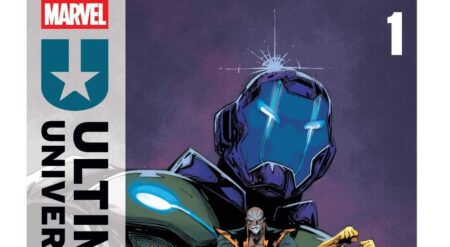
Champions #6 is published by Marvel Comics. A new creative team takes over the series as Danny Lore becomes the writer and Luciano Vecchio is the artist. Federico Blee remains the colourist, as does Clayton Cowles as the letterer. Progressing after the events of Outlawed, the team has reformed and is back in action. Working together, the young heroes battle villains as if everything is back to normal. But Kamala’s Law is still in place, and the internal battle within the squad does not heal so quickly. And Roxxon decides that a rebrand is in order after the part they played in the previous arc…
The story and plot structure are fantastic within this issue. Although Lore is the new writer, they do not forget the huge story that preceded them. They take what Eve Ewing provided and details that there are ramifications for those events. A storyline such as Outlawed can’t just stop and it is important that the transition between creators continues seamlessly. Themes such as responsibility and accountability will be prevalent as conflict gets more intense.
The structure allows for a superb story to be told. It opens with an extremely entertaining battle, getting the reader excited. After that comes the trouble within the team, as tensions flare. And throughout this the villain of the series start their machinations. The plot moves at a terrific pace, each scene feeling lengthy and absorbing. The ending doesn’t have a huge surprise, but it is great at setting up what we can expect from this arc.
One of the best aspects of Champions #6 is the characters, which have always been the selling point of this team. Lore’s depiction of the team is fantastic. The main team within this issue consists of five members; Ms Marvel, Ironheart, Viv Vision, Spider-Man and Nova. But there are hints at more members having a roll within the series. The writer greatly accomplishes his tackling of the character’s arcs that have already started whilst implementing his own chemistries.
The consequences of Outlawed is felt within the personalities of the heroes as they still reel from the trauma they face. Riri is still angry at the government and Roxxon for the damage they did inside their reeducation centres, and does not trust Viv at all after she betrayed the entire time. The android is trying to recover herself, attempting to rebuild trust within the group. The contrast in the attitudes of the characters is crucial when there are such profound ideas being presented with them inside it. The dialogue amplifies their voices, the arguments between the team consisting of some personal but necessary confrontations.
Vecchio is a fantastic partner within this comic, brilliantly suited for a book filled with young characters. Youthful energy is exuded from their movements, rife with energy and liveliness. The fight scene has magnificent choreography. There are a lot of characters but each of the heroes exhibits a different stature and physical presence. They jump between opponents, switching targets and fluid in their engagement. The designs of the guest star villains are clever and dynamic considering their rather brief appearance.
Vecchio’s proportions are exaggerated in a very fun method within Champions #6. The eyes and mouths are large but not unpleasantly so. The scale of these features often depicts really detailed and recognisable emotions. Each of the protagonist’s face is so expressive when they are angry or surprised. The cartoony aspect of Vecchio’s style is perfect for the subjects within the comic.
Consistency appears to be an important factor as the creative teams change, so keeping hold of Blee on colours is very helpful in maintaining that. The colours are always bright and vibrant, even when the mood of the scene doesn’t mimic that emotion. Each of the costumes for the characters is full of dynamic and lively shades, as lots of pinks, greens, yellows, blues and reds are used on the uniforms. There is a simplicity that often takes place in the background of the panels. Whilst they have detailed lines, the colours are mostly faded and darker than the foreground. This prevents any clashing or abrasiveness, the subject of the panel always the most important target for the readers’ eyes.
Cowles stays on lettering and is fantastic again. Each word balloon appears to be its own shape, which boosts the energy of the text within them. SFX is used often and is very welcome in the chaotic and exuberant fight scenes. The structure of the letters certainly affects how they “sound.”
Champions #6 is an excellent continuation instead of a fresh start. This issue tackles the fallout of the earlier five issues. The writers do have their own identities, but the plot threads that Ewing left behind are picked up and continued by Lore as their own plot takes shape. The characters shine, five profoundly different personalities complementing and clashing with each other. The art style and bright colours are exactly what the book needs to draw the attention of younger readers and is superb at helping tell the story.
Champions #6 is available where comics are sold.
TL;DR
Champions #6 is an excellent continuation instead of a fresh start. This issue tackles the fallout of the earlier five issues. The writers do have their own identities, but the plot threads that Ewing left behind are picked up and continued by Lore as their own plot takes shape. The characters shine, five profoundly different personalities complementing and clashing with each other. The art style and bright colours are exactly what the book needs to draw the attention of younger readers and is superb at helping tell the story.







